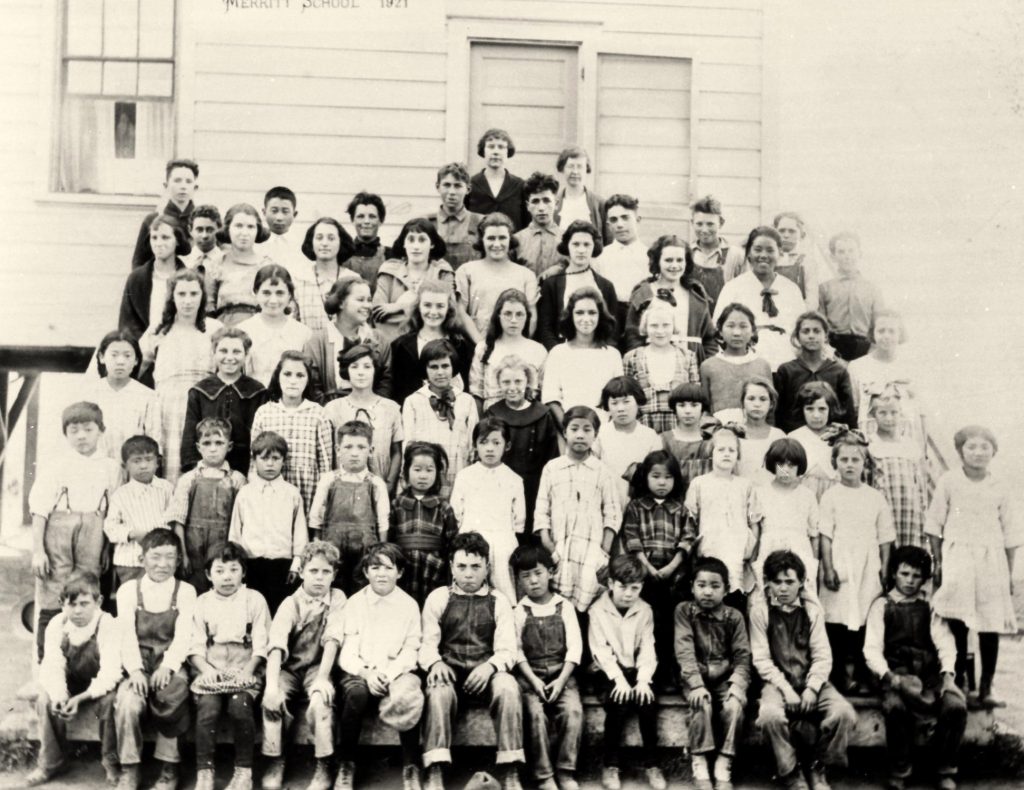Clarksburg: an Exception to School Segregation

Photo courtesy of Clarksburg Library Collection and Friends of the 1883 Clarksburg Schoolhouse
Class photos have an eternal charm, with their mix of children who are happy, grumpy, candid, posed, awkward, or indifferent (and inevitably at least one with wildly unkempt hair). This 1921 photo from Merritt School – now known as the 1883 Clarksburg Schoolhouse – is no different.
But there’s something about this photo that is not eternal, and actually surprising for its time: diversity. White and Asian children – probably mostly Japanese-American – are interspersed randomly, as you would expect to see in a school photo taken today, over 100 years later.
Ethnic diversity has been a hallmark of the Delta since the fertile farmland here was “reclaimed” from swamps, drawing settlers from China, Holland, India, Italy, Japan, Mexico, the Philippines, and Portugal.
Racial harmony, however, was not a given. After arriving in the late 1800s, Japanese immigrants quickly met with success in farming[i], and then backlash. By 1913, the state had passed the Alien Land Law prohibiting Japanese and other Asian immigrants from owning land or leasing land for more than three years[ii]. And in 1921, state-sponsored segregation began, though schools in nearby communities were already segregated.[iii]
Not Clarksburg, though. “It was always integrated,” said Steve Hiromoto, a resident historian for Clarksburg’s Japanese community whose great, great grandfather arrived in Clarksburg from Japan in 1898.
There actually was a Japanese school in Clarksburg: Holland Union Gakuen. Built in 1925, Hiromoto said, it was not an alternative school for Japanese-American children, but rather an additional school that would help the children retain Japanese language and culture.
What was it about Clarksburg that fostered integration even as there was segregation in nearby communities? Hiromoto speculates that it may be the nature of the community, with all members focused on farming.
“My family assimilated with the community because it was a farm-based community, and they were involved in a lot of activities the other farm families were involved in,” he said. “They felt welcome and able to contribute where they could.”
In other communities, there were distinct Japantown districts where immigrants might be more likely to live and socialize mostly with fellow Japanese immigrants. “Clarksburg didn’t have a situation like that,” Hiromoto said.
Clarksburg public schools remained integrated for two more decades after this photo was taken, and it was not a community decision that ended it – it was the President of the United States. The U.S. had entered World War II, and fear and distrust of the Japanese was running high, so on February 19, 1942, the president issued Executive Order 9066, ordering 110,000 people of Japanese ancestry into relocation camps. All of Clarksburg’s Japanese-American families had to leave.
Many didn’t return, but the Japanese presence in the Delta remains. Of 100 Japanese-American families that left the Clarksburg region, about 25 came back, and 10 of those remain in this small farming community to this day. Walnut Grove has an operating Buddhist temple. And Isleton’s and Walnut Grove’s Japantowns are on the National Register of Historic Places. All are living facets of history in the Sacramento-San Joaquin Delta National Heritage Area.
The school pictured in the photo above is being restored by a community group called the Friends of the 1883 Clarksburg Schoolhouse, with support from the Sacramento-San Joaquin Delta Conservancy (grants for restoration and property acquisition), the Delta Protection Commission (feasibility study and interpretive guidance) and many individual donors in the community. Learn more at www.1883clarksburgschoolhouse.org.
[i] Jennifer Helzer, California State University, Stanislaus, “Building Communities – Economics & Ethnicity”
[ii] Philip Garone, California State University, Stanislaus, “Managing the Garden: Agriculture, Reclamation, and Restoration in the Sacramento San Joaquin Delta”
[iii] Jennifer Helzer, California State University, Stanislaus, “Building Communities – Economics & Ethnicity”

